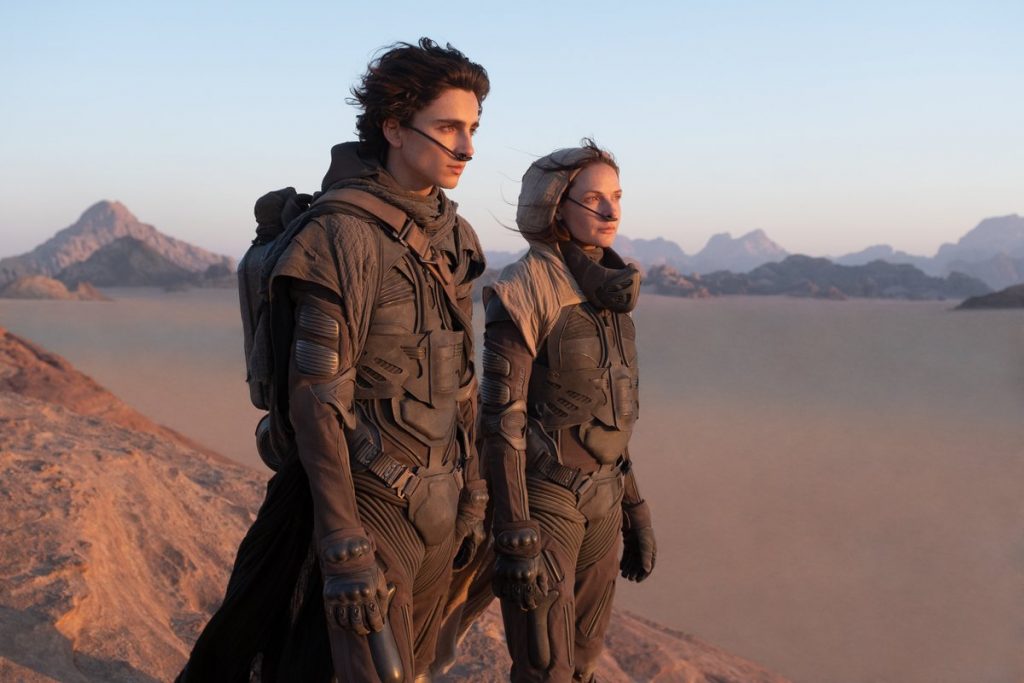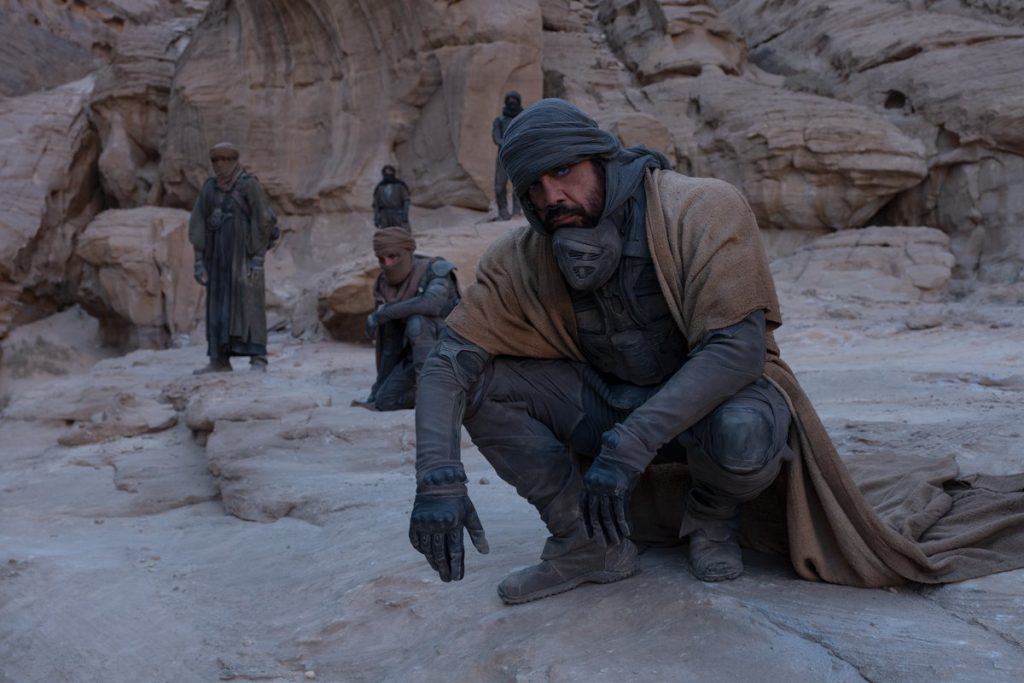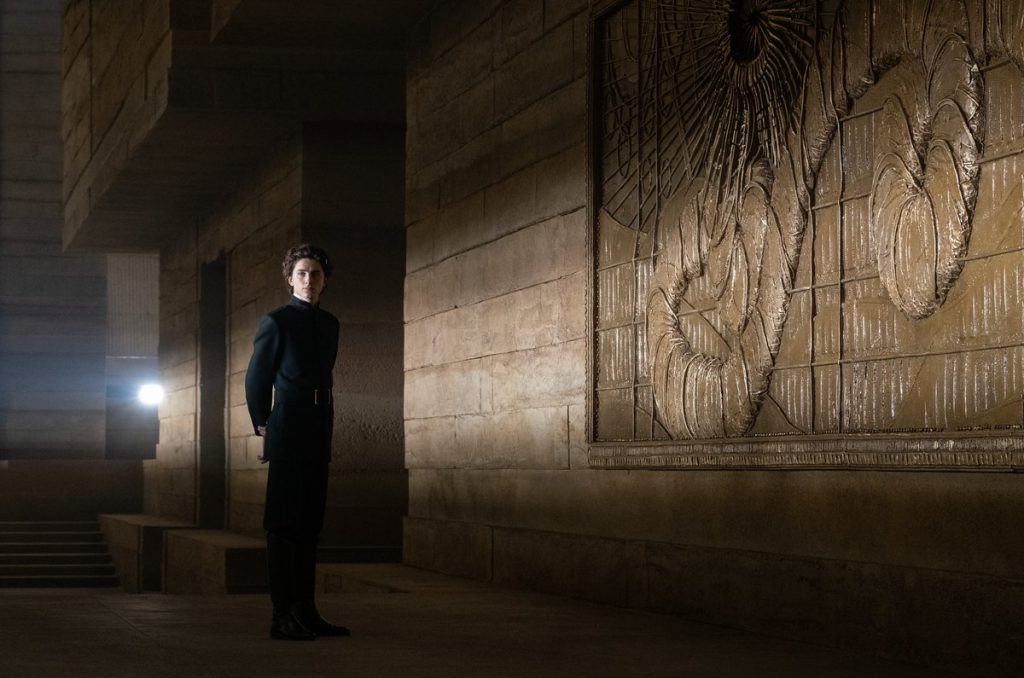Dune: The Designer’s Craft

“The design is not just what it looks like and feels like. The design is how it works.” – Steve Jobs
He’s always had something for the desert. Clean, pale, white, an austere scenography that clashes with the deep blue of the evening sky. In the background, we discern a longer line of desert hills. The man wears a somewhat scornful smile on his face, radiating a boyish air: “Bonjour”, he says in his Québécois accent, “mon nom c'est Denis Villeneuve.” On his back hangs a long, white robe; he holds a black microphone in his hand. The scene dates from the early 1990s, when Villeneuve won a Canadian youth film contest with a short film set in the Eurasian desert.1
The desert aesthetic in question recurs across Villeneuve's oeuvre, from Blade Runner to Arrival, but it ultimately refers to one of his main sources of inspiration: the ‘Dune’ series written by American science fiction author Frank Herbert, which began to dominate the American West Coast and then took the alternative book circuit by storm in the late 1970s. For years, the director dreamed of bringing Herbert to the big screen, with enough financial clout and logistical support – an arsenal only a major studio could offer him. In the autumn of 2021, after some obligatory COVID delays, the day came: a childhood dream come true.
Villeneuve's Dune also opens with a dream, announced with thumping basses. The scene is followed by an opening shot of the desert, the primary setting for both Herbert and Villeneuve. Large spaceships dock on a planet, nomads wander through the desert. Villeneuve hardly had to fantasize his world into existence: the spaceships, planets and palaces were once described in detail in some of the best fantasy books in the genre.
As in Herbert's original, mankind inhabits a galactic realm with barely any memories of the human earth. The House of Atreides is summoned by imperial decree to assume rule of the desert planet Arrakis – also known as Dune – from the Harkonnens, who manufactured a product called spice there. Space travel is impossible without the product. The House of Atreides soon finds itself in a trap: the Harkonnens conspire with the emperor and retake the planet. Paul and his mother manage to escape into the desert, homeland of the Fremen, the tribe that has led a nomadic existence in the planet’s caves. Villeneuve's version ends abruptly: the knife has been sharpened but it hasn’t yet cut (Dune: Part Two is supposedly on its way).
“Seek by very diligent work... to master content. The form will be thrown to you”, the Dutch novelist Eduard Douwes Dekker once claimed. For Dune, Villeneuve reversed Dekker’s formula. The content was dropped into his lap – partly by Herbert's original, partly by Lynch's illustrious adaptation. And Villeneuve assumes the role of the designer, an assignment he takes up with brio. Minimalist, steeped in brown earth tones and ochre skies, Villeneuve sets up a stylistic world with characters walking around like silhouettes on a fashion show. “I like the desert because it is clean”, Peter O'Toole stated in Lawrence of Arabia, a reference quoted by the Belgian film critic Patrick Duynslaegher.
This aestheticism also corresponds to Dune’s story, which takes place in a universe that mixes technical refinement with brutal feudal subjection. Herbert himself repeatedly drew a parallel with the late Ottoman Empire: a group of feudal houses played against each other by an overweening empire, threatened by external colonists and international power players. The scion of one of the noble families treks into the desert and duels with one of the local warriors. After the victory, his messianism is confirmed; he soon converts to the monotheism of the sand people. Somewhere it is implied that an order of nuns introduced the religion to the planet, an old plan to change history’s course.
Yet the nomads’ faith also has an egalitarian edge: the rule by the strongest implies rotation and alternation. Anyone can challenge the leader. Herbert himself was once sent by the US Army to “look after” natives on a Pacific Island who adhered to a similar culture of honor. The Fremen are violent but noble, hunter-gatherers who live in harmony with nature, unlike the urban proletariat who lease out their services to the aristocrats and no longer know craftsmanship (the same nomads were portrayed by Villeneuve in his Terre des Hommes, in which he tracked a group of Nepalese horsemen).
The Fremen are hopelessly superstitious, but always remain potentially emancipatory. Under messianic tutelage, the crusaders can eradicate urban civilization and build a better world for the Arrakites. Then there are the worms, which the Fremen venerate as both allies and gods – the “Shai-Hulud”. Villeneuve does not hold back: his creatures are big, inhumanly big, with piercing tentacles, curving teeth and scaly skins that give them all the characteristics of prehistoric monsters. Their maws are fringed by long, curling labia, an arse like a carnivorous flower devouring man and machine. Roving underground, Villeneuve’s creatures traverse the planetary deserts, like submarines with their sondes. In Dune, nature is sovereign in its inexorability. Paul Atreides must subdue this nature to restore both a cosmic and political balance; the aristocratic rebel who will join the nomadic people for their palace coup. As the US withdraws from Afghanistan and the Taliban swiftly retakes the country, Villeneuve predicts the revenge of the desert.

Herbert's Dune also offers us a vista of another era – those other 1960s – here presented as the dream of a right-wing hippie who never saw drugs and space travel as antidotes to hierarchy and dictatorship. In Herbert’s books the reflections on empires and dynasties always retain their reactionary edge; there is little sign of Democrats or liberals in Dune's universe. Everyone is a settler, everyone is on the hunt for territory. There is no libertarian emancipation or cybernetic utopia here, but a clan war that can only culminate in a crusade.
The contemporary resonances of this vision will hardly surprise. The main jobs on Arrakis are in the spice industry or as household help in the palace. Space travel does not appear to be an adventure but a tiresome, dull affair. On Arrakis there once existed a plan to set up ecological testing stations that would draw water from the ground. Then spice – read oil – was discovered and the plans for Arrakis’s green transition were soon shelved. The distant desert planet is dry and unlivable, the home of Saudi oil barons who survive in their compounds with air conditioning (the white robes of “a new and sudden universal priesthood of pure money”, as the writer V. S. Naipaul already described the Saudis in 1970s London).
Others survive as vagrants outside the city walls, at the mercy of poachers or the imperial guard. The spice stations employ engineers and miners who are paid from the profits of the dynastic houses, under perpetual threat from the worms. Without food, there can be no travel in space – it’s the petrol of the future. An economy that has been generating badly paid service jobs for forty years, a state increasingly weak in the face of commercial players themselves caught in a quasi-royal competition – Dune's popularity is quickly explained. High-tech capitalism and ancien régime do go together after all. More than hippie escapism, Herbert's Dune thus offered a nightmare vision for the 1970s: what would become of the American empire once the pits closed and only oil could keep the international economy adrift? The fever dreams of petro-capitalism.
Little of this political depth survives Villeneuve's treatment. The term “jihad” is carefully avoided or covered up with orientalist clichés. Of the imperial attributes in Lawrence of Arabia, only the monochromatic desert remains. On Arrakis, we see the planet reflected in the eyes of the courtiers in the palace's hanging gardens. We observe a gardener watering trees in an imperial courtyard, while an army of pilgrims is thumping fences in the background. Who are they? What drives them? Not a single marketplace or city street itself is shown. The mujahedin are given a scant twenty minutes. Herbert's “Guild Navigators” – creatures who have morphed into large, ambulatory brains through prolonged exposure to spice – are nowhere to be seen. Sociology and politics are systematically shunned. In Dune each clan first appears as an ethnic template: the sharp jaws of the Atreides, the weather-beaten skin and azure eyes of the Fremen, the Harkonnens pacing their ships like vampires while blasting their enemies with drones and missiles.
Baron Harkonnen is a terror. His iron lung not only assists his breathing but also allows him to hover above his enemies. Yet his malice also comes across as slightly rudderless. Lynch opted for the more clownish villain in his version: the harlequin who pops radioactive pustules in his salon while his henchmen torture a group of informers. Villeneuve goes straight for the ghost: the patriarch who wants to reproduce his body and brethren at all costs, mobilizing the most expensive pacemakers and medicines, mud baths and concubines. He earned his assets on the intergalactic stock exchange. Stellan Skarsgård provides a superb rendition of the obese impresario, but what does the man believe in? What is his plan for the empire? What is his money for? Here we are dealing with racial blocs and alliances, not the factions of Herbert's original, which adhere to different ideologies and want to furnish the universe differently. Here, only soulless will to power.
The end result often feels like a well-designed Apple computer, or a chic villa in the Hollywood hills. Sublime and grand, but also overwhelmingly sterile, the culmination of a long, methodical flattening. The depth in Herbert's books grants relief to the characters, which in turn would cause graininess or grittiness on screen. Villeneuve has no time for grittiness. Like O'Toole, he prefers to keep it clean. And much like his implicit hero Steve Jobs, Villeneuve possesses the ability to reduce questions of content to mere formal puzzles – “design is not just about how something looks or feels; design is about how something works” is the motto he lifted from Jobs.
Nor does Dune have the slightest pretension to work on a small screen. Here, a highly stylized, hyper-technological, clever, and above all expensive, spectacle is served up. Villeneuve’s flattening operation is not the result of a narrative defect, but the purpose of his whole enterprise: this is how Dune functions as a “film”. In that reduction a thick layer of Herbert's world is simply shaved off, “a circus”, as a French critic remarked, that lives off “the pleasures of occultation”.
This need not only lead to pessimism. Despite its flattening Dune is grandiose, enjoyable, perennially user-friendly; a ghost can still be seen somewhere deep inside the entrails of the new machine. But user-friendliness is not yet beauty, cleverness not yet intelligence, enjoyability not yet enjoyment. And a well-designed machine is not necessarily a work of art.

- 1Terre des Hommes (Denis Villeneuve, 1991).

